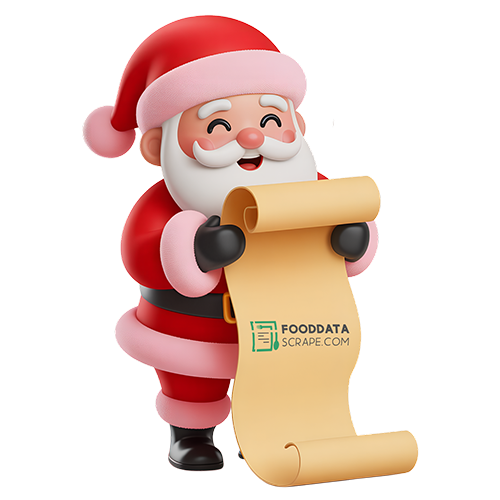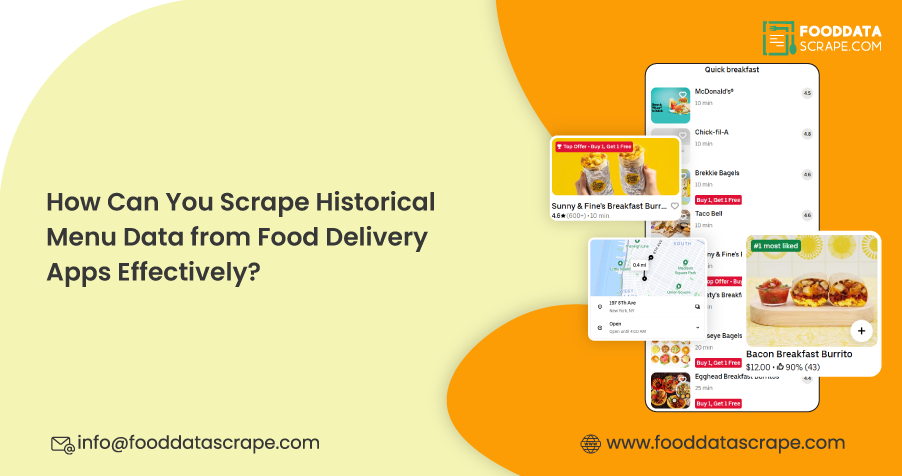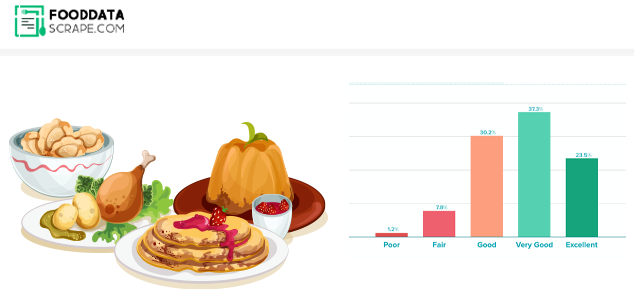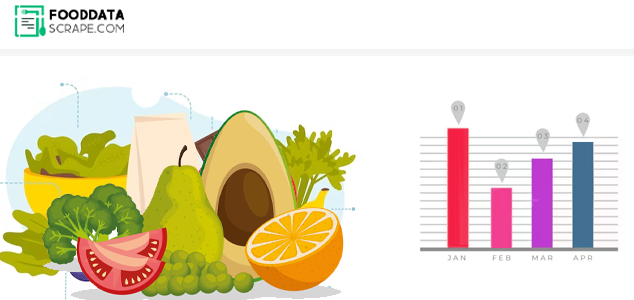Introduction
Food delivery continues to evolve rapidly, with menu items constantly changing. It is a state of constant flux, where items are introduced and discontinued, prices change, and customer demand determines which menu listings are retained. Understanding this change is crucial for brands, researchers, and analysts seeking to comprehend how digital food trends have evolved. One popular approach is to Scrape Historical Menu Data from Food Delivery Apps. This allows access to potential deep archives of previous menus, previous pricing models, and previous strategies of restaurants.
Extract Past Menu Listings from Food Delivery Platforms to compare menus from the past and present, understand long-term trends in cuisine popularity, and analyze how food operators respond during periods of economic upheaval, health trends, pandemics, and other events. An understanding of history provides value for restaurant entrepreneurs, marketers, and data specialists.
When you Scrape Historical Menus from Food Delivery Websites, you will harness years of consumer behavior data, whether it is the surge in comfort food orders in early 2020, the spike in plant-based offerings post-pandemic, or the seasonal variation of items that still occur.
Why Scraping Historical Menu Data Matters?
Scraping historical menu data is crucial for understanding how food trends, pricing, and consumer preferences have evolved. It enables restaurants, analysts, and food delivery platforms to uncover past successes, track pricing patterns, and forecast future demand. By accessing archived menu data, businesses can make more informed decisions and adapt their offerings based on proven performance and market shifts.
- Menu Trend Analysis Over Time: Historical data is a goldmine for identifying what dishes trended, when, and why. Was there a surge in vegan options during 2021? Did certain cuisines grow in popularity in specific regions? Only with time-based data can you provide an honest answer to such questions.
- Price Evolution Tracking: Tracking how food prices changed on delivery apps gives insights into inflationary patterns, surge pricing trends, and restaurant pricing strategies. This data also helps food analysts build accurate pricing models.
- Consumer Behavior Insights: Analyzing which dishes were popular during lockdowns versus post-pandemic recovery phases helps platforms better understand changing customer preferences, enabling them to develop more effective app algorithms and promotional strategies.
Types of Historical Data You Can Extract
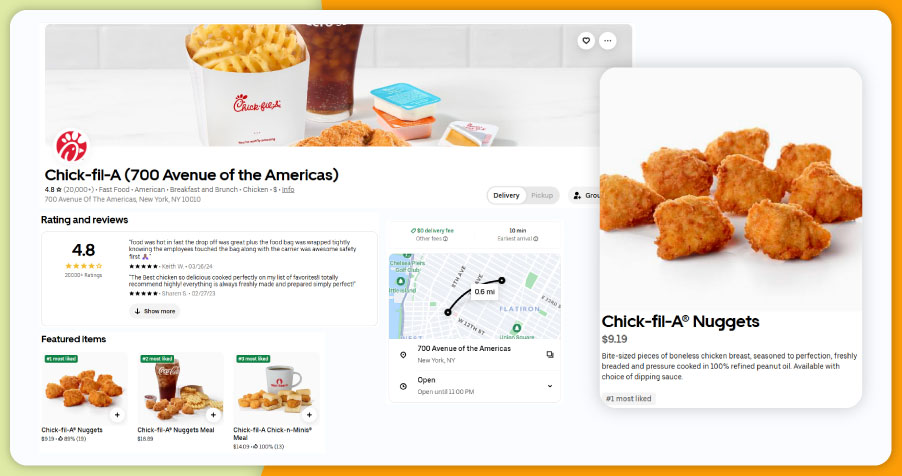
Using Historical Food Delivery Menu Data Scraping, several key types of information can be captured and analyzed:
- Dish Names & Descriptions: How names and presentation styles evolved.
- Cuisine Categories: Growth of niche categories like keto, gluten-free, vegan.
- Pricing: Price fluctuations over months and years.
- Menu Positioning: What items were promoted as "most popular" or "recommended"
- Item Availability: What items went out of stock or disappeared from menus during specific periods?
- Images & Media: Changes in visual presentation, which influence ordering decisions.
Key Use Cases of Historical Menu Scraping
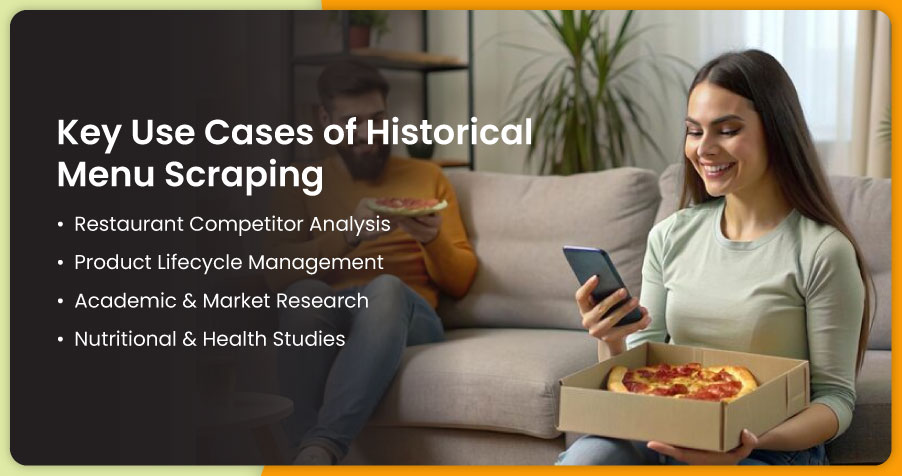
Historical menu scraping offers valuable insights across the food industry. By analyzing competitor strategies and pricing shifts, as well as tracking food trends and consumer preferences, this data enables smarter decision-making. Key use cases include restaurant benchmarking, product lifecycle analysis, academic research, and nutritional trend tracking—helping businesses, researchers, and platforms stay informed and strategically aligned with evolving market demands.
- Restaurant Competitor Analysis: Using Food Menu Data Scraping for Historical Analysis, restaurant owners can review how their competitors' menus evolved—what worked, what was discontinued, and how their pricing strategy adapted to market forces.
- Product Lifecycle Management: Understanding which dishes had short or long menu lives can help restaurants decide whether to bring back discontinued items or launch limited-time offers.
- Academic & Market Research: Universities and market research firms benefit from accessing historical food data to study long-term trends in food consumption, cultural shifts, and the economic impacts on dining habits.
- Nutritional & Health Studies: With increased attention to health, scraping historical menus helps assess how healthy food options have increased (or not) on mainstream platforms over time.
Platforms for Historical Menu Data Scraping
Several major platforms offer rich opportunities for scraping historical menu data. Apps like Uber Eats, DoorDash, Zomato, and Deliveroo have hosted evolving restaurant menus for years. By targeting these platforms, businesses and analysts can access archived listings, monitor pricing changes, and track dish popularity over time, unlocking valuable insights into how digital food offerings have shifted from pre-2020 to now.
- Uber Eats, DoorDash, Grubhub: These platforms have rich archives of restaurant menus, often with timestamped updates, allowing analysts to backtrack to earlier versions via web archives or stored datasets.
- Zomato & Swiggy: In emerging markets like India, these platforms reflect local food trends. Their archived listings are ideal for regional analysis.
- Deliveroo & Just Eat: These platforms help track menu shifts in European regions. Local food laws, seasonal ingredients, or regional preferences may influence items.
How to Scrape Past Menu Data from Food Apps?
To Scrape Past Menu Data from Food Apps, a combination of web scraping and archived tools is often used. Here's a structured approach:
- Use Web Archives (e.g., Wayback Machine): Review snapshots of popular food delivery websites from before 2020. These snapshots contain historical pages of menus and restaurant listings.
- Deploy Python Scrapers with Time-Based URL Tracking: Create scripts that simulate past searches, using archived URLs and metadata. This method helps gather structured data from saved web pages.
- Extract Data from Stored Datasets: Some delivery platforms offer API-based access or publicly available datasets that include historical menu data.
- Leverage Food Delivery Data Scraping Services: Professional services offer targeted scraping with storage, timestamps, and analysis-ready formatting. These services are ideal for companies lacking technical scraping capabilities.
Technologies Used
To perform large-scale historical scraping, a mix of tools and technologies is required:
- Python Libraries (BeautifulSoup, Scrapy, Requests)
- Web Archive Crawlers
- MongoDB/SQL Databases for time-series storage
- Timestamped Logs to track menu changes
- Food Delivery Scraping API Services for accessing structured data feeds
Sample Timeline: Pizza Menu Analysis (2018–2025)
Using insights gathered through Restaurant Menu Data Scraping, the table below reflects how menu pricing, popular items, and new toppings have evolved on major food delivery apps:
| Year | Avg Pizza Price (EUR) | Most Popular Pizza | New Toppings Introduced |
|---|---|---|---|
| 2018 | €7.50 | Margherita | None |
| 2019 | €7.80 | Pepperoni | Jalapeño |
| 2020 | €8.10 | BBQ Chicken | Smoked Gouda, Vegan Cheese |
| 2021 | €8.50 | Veggie Supreme | Zucchini, Artichoke |
| 2022 | €8.80 | Four Cheese | Plant-Based Pepperoni |
| 2023 | €9.00 | Spicy Meat Feast | Sriracha Swirl, Gluten-Free Base |
| 2024 | €9.40 | Vegan Deluxe | Truffle Oil, Kale |
| 2025 | €9.70 | Mediterranean Feta | Black Olives, Sun-Dried Tomatoes |
This extended dataset, scraped using Scrape Historical Menu Data from Food Delivery Apps, helps highlight how consumer taste has gradually shifted toward Mediterranean, plant-based, and spicy options. The consistent rise in pricing also reflects inflation, increased ingredient variety, and premiumization across menus.
Start scraping historical menu data now to uncover past trends, optimize strategies, and elevate your food delivery insights!
Benefits of Historical Menu Scraping for Food Businesses
Leveraging historical menu data offers strategic value to restaurants, delivery platforms, and food tech companies. By analyzing past offerings, businesses can make informed decisions that enhance customer experience, boost sales, and streamline operations. Below are four impactful ways historical data drives smarter planning and innovation in the food delivery ecosystem:
- Optimize Future Menus: Analyzing which dishes succeeded or failed in the past helps restaurants avoid repeating mistakes and replicate successful strategies. By understanding which meals resonated with customers, menu designers can refine current offerings to align with proven customer preferences, pricing sweet spots, and popular combinations.
- Plan Seasonal Items: Seasonal menu items often drive spikes in engagement and sales. Historical data reveals when certain dishes—like pumpkin spice items or festive platters—performed best. This insight allows businesses to strategically launch or retire limited-time offerings based on historical patterns and seasonal demand.
- Track Competitive Shifts: Reviewing past menus of competitors shows when they introduced or removed items, adjusted pricing, or changed descriptions. This intelligence helps brands anticipate market moves, respond with agility, and identify product gaps that can be capitalized on for differentiation.
- Build Better Algorithms: For food delivery platforms, analyzing historical menu data improves AI-based recommendation systems. By identifying patterns in popularity, customer reorders, and time-based trends, algorithms can offer more relevant suggestions, increase customer satisfaction, and drive higher order conversions.
Who Needs Historical Menu Data?
- Food Delivery Apps: Apps like Uber Eats, Swiggy, or Deliveroo use this data to enhance AI-based recommendations and user experience.
- Franchise Chains: Chains use data to localize menus and plan new rollouts based on regional preferences.
- Investors and Analysts: They analyze business success factors like pricing strategy and menu composition during growth periods.
- Marketing Teams: Helps create more compelling product narratives using the evolution of popular dishes
Challenges in Scraping Historical Food Data

- Incomplete Archives: Some platforms limit visibility or archive poorly.
- Changing Website Structures: Old HTML structures may break scraping logic.
- Time Constraints: Manually collecting and validating years of data is time-intensive.
- Legal Considerations: Respecting terms of use is essential when scraping data.
Partnering with professional Food Delivery Data Scraping Services ensures smooth, compliant, and scalable operations.
How Food Data Scrape Can Help You?
- Dedicated Support Team: Our team monitors scrapers 24/7 and acts fast when websites update or change layouts.
- Legal & Ethical Compliance: We follow GDPR and platform-specific scraping terms to keep projects sustainable.
- Competitor Price Intelligence: We specialize in scraping product pricing from direct competitors for market benchmarking.
- Flexible Scheduler System: Schedule scrapers by minute, hour, or day, based on project sensitivity.
- Industry-Specific Scrapers: Whether grocery, fashion, electronics, or real estate, our tools are purpose-built for the target industry.
Conclusion
As the food delivery ecosystem continues to innovate, understanding its past becomes more important than ever. When you have access to historical menu data, you gain a strategic edge—allowing you to anticipate trends, tailor menus, and design offerings that resonate with evolving consumer tastes.
By investing in Restaurant Data Intelligence Services, businesses can align their strategies with proven success patterns from the past. Tools like a Food Price Dashboard offer dynamic insights into how pricing and dish popularity evolved over time, while curated Food Delivery Datasets fuel market research, product development, and competitive positioning.
In an age where every dish, price, and description leaves a digital footprint, embracing Food delivery Intelligence Services isn’t just smart—it’s essential for staying ahead in a data-driven food landscape.
If you are seeking for a reliable data scraping services, Food Data Scrape is at your service. We hold prominence in Food Data Aggregator and Mobile Restaurant App Scraping with impeccable data analysis for strategic decision-making.

